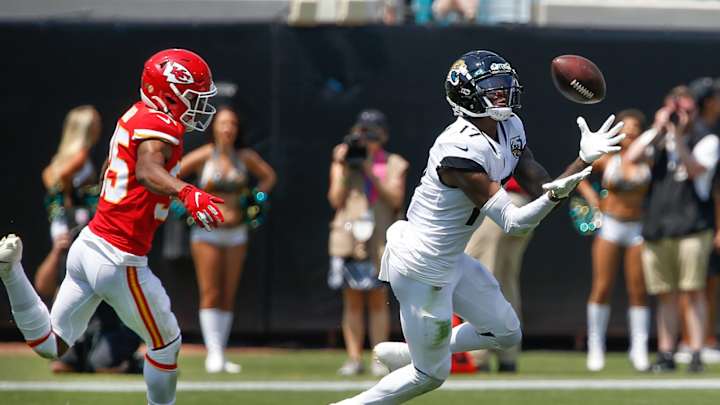Examining Jaguars Wide Receiver DJ Chark's Breakout 2019 Season

Jacksonville Jaguars wide receiver DJ Chark was a true breakout player last season, taking the kind of second-year leap the Jaguars desperately needed for their offensive hopes. The 2019 second-round selection had just 14 receptions, 174 yards and no touchdowns on 32 targets in his rookie campaign but exploded for 73 receptions, 1008 yards and eight touchdowns on 114 targets last year.
Chark’s superb 2019 season didn’t just make him Jacksonville’s leading receiver (he led the team’s receiver unit in every major statistical category sans yards per reception), it also catapulted him as one of the league’s leading receivers.
Chark played ranked top-25 in targets, receptions, yards and touchdowns among all wide receivers last season despite missing a game due to injury. He also ranked well in many advanced statistics - Chark finished top-25 among 79 receivers with at least 50 targets in Pro Football Focus receiving grade, Sports Info Solutions receiving points earned and Air Yards weighted opportunity rating.
Chark’s 2019 performance was impressive in part because his rookie season was so underwhelming. It isn’t uncommon for receivers to make a sophomore leap, but Chark’s drastic breakout was exceptional. Chark had the eighth-largest yardage increase in his second season among 619 receivers drafted from 2000-2018, per Sharp Football Analysis.
The seven players with a larger yardage increase were Alshon Jeffrey, Brandon Marshall, Antonio Brown, Steve Breaston, Allen Robinson, Josh Gordon, and Chad Ochocinco. That’s a talented group of receivers to say the least.
The other reason Chark’s 2019 season was impressive is because of his surrounding environment. 82% of his targets were deemed catchable, which ranked 44th among eligible receivers per SIS. Gardner Minshew certainly delivered some highlights but overall he was among the least efficient quarterbacks in the league last season. Nick Foles, who played in four games, also played poorly.
The Jaguars ranked 26th in points scored and 24th in offensive Expected Points Added (EPA) per play. Chark’s ability to produce in a meager offense with inefficient quarterback play is truly impressive. 27 receivers earned a PFF receiving grade of at least 75.0 last year- just seven of them played with a bottom-half PFF graded quarterback in a bottom-half scoring offense, and Chark was one of them.
Minshew was inefficient in general, but his game improved when Chark was involved. According to PFF, Minshew posted 9.3 yards per attempt, a 109.0 passer rating and 0.38 EPA per play when targeting Chark. When targeting all other Jaguars receivers, Minshew produced 7.2 yards per attempt, a 97.0 passer rating and 0.12 EPA per play.
Chark was Minshew’s favorite target in just about any scenario. Chark received the most first down, third down, red zone and deep targets from Minshew last year. Minshew played best when he was able to get the ball out of his hands quickly, and Chark was typically his primary target.
Chark started hot in 2019 as he accumulated 38 receptions for 660 yards and six touchdowns on 61 targets in the first eight games of the season. He led the AFC in receiving yards and touchdowns in this period. But in the second half of the season, Chark totaled 34 receptions for 348 yards and two touchdowns on 57 targets.
Chark’s slight descent was largely a result of both an ankle injury and worsened quarterback play. Minshew had a promising start to the season but struggled down the stretch, and he and Foles took turns replacing one another in the starting lineup.
As a result, Chark’s production took a hit, especially on deep passes. In the first half of the season, Chark caught 11 of 16 passes for 374 yards and three touchdowns on throws 15-plus yards downfield. In the second half of the season, Chark caught just four of 15 such passes for 91 yards and one touchdown.
Chark’s downfield success declined over the course of the season, but the team still made a point to get the ball to its top receiver. Chark had zero screen targets in the first half of the season but received nine screen targets in the second half. Jacksonville was also able to generate targets for Chark through quick play action throws.
Here is 77 seconds of Jax getting the ball to D.J. Chark via play action flats pic.twitter.com/iEmuQR6Acn
— Gus Logue (@gus_logue) June 10, 2020
Chark wasn’t an elite route runner or tackle breaker (which isn’t to say he was flawed in those areas), but rather his biggest strengths were the ability to win at all three levels of the field and consistently make contested catches. His 2.7% drop rate last season was sixth-best in the league, per PFF, and is a huge improvement over his 2018 26.3% drop rate.
Chark earned his role as the focal point of Jacksonville’s passing attack and made a positive impression on Jay Gruden, the Jaguars' new offensive coordinator. Gruden recently hinted that he’d like to use Chark in the slot more often, which would likely yield fruitful results: Chark produced 10.3 yards per target in the slot versus 8.5 yards per target on the perimeter, per PFF.
Chark will turn 24 in September and still has two years remaining on his rookie contract. Considering his rapport with Minshew, Gruden’s influence, and the likelihood that the Jaguars will be throwing the ball often in negative game scripts, Chark is in a great position to build upon his breakout season in 2020 and beyond.
